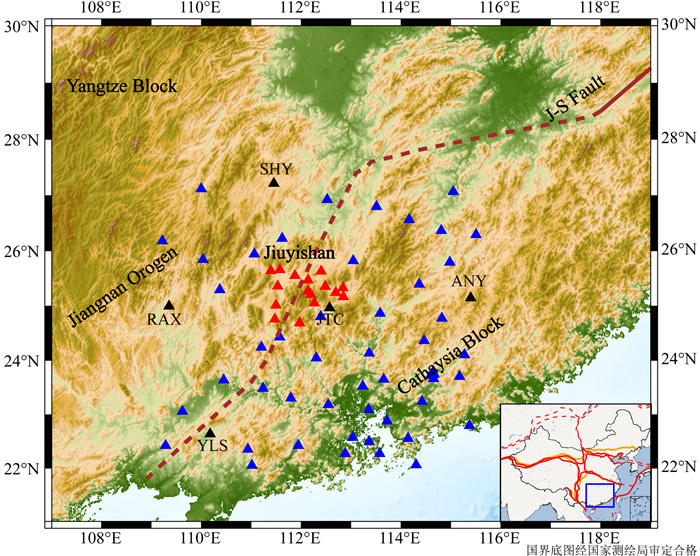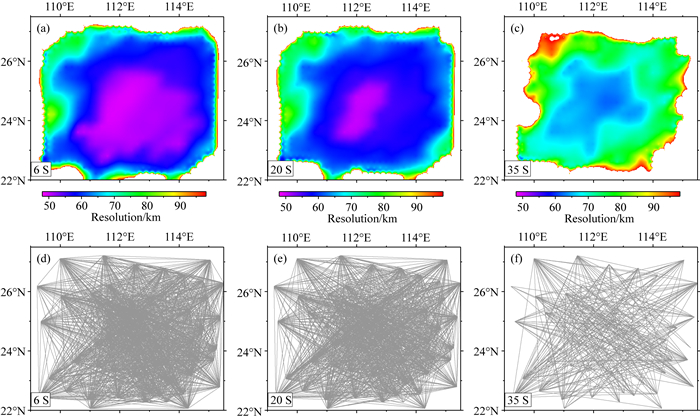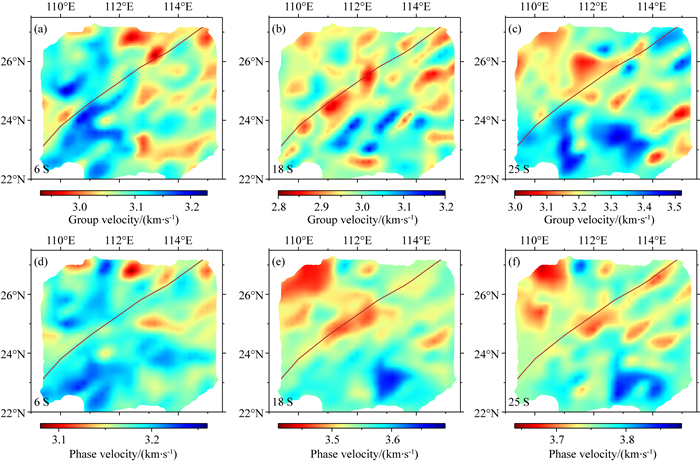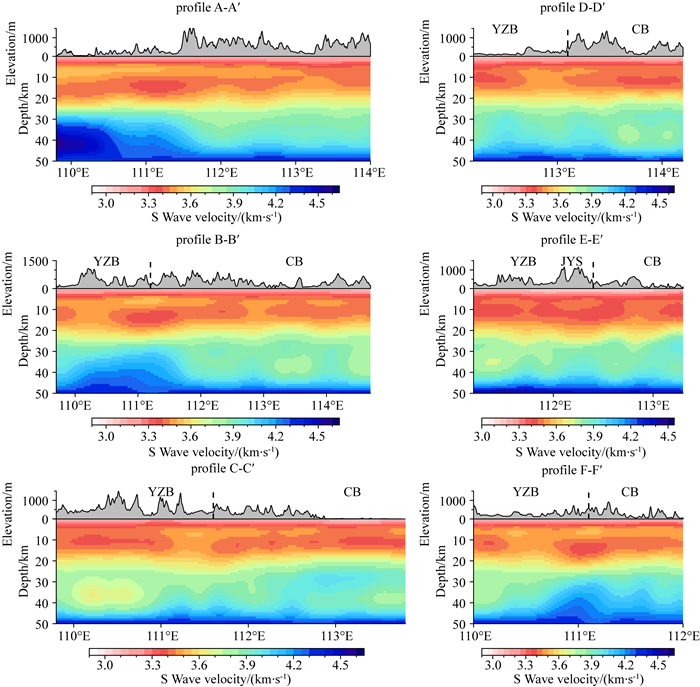2. 中国科学院大学, 北京 100049
2. University of Chinese Academy of Sciences, Beijing 100049, China
华南块体位于欧亚板块的东南部,是中国大陆的主要构造单元之一,其主要由北西方的扬子块体和东南方的华夏块体组成(Zhang et al., 2012;Zhao and Cawood, 2012;张国伟等,2013).目前大多数研究认为华南块体是由扬子块体与华夏块体沿江山—绍兴缝合带在中元古代晚期至新元古代早期合并形成,并同时形成位于扬子块体东南边缘的江南造山带(Li et al., 2016, 2018, 2009b;Wang et al., 2007)(图 1).江南造山带作为两个块体之间的弧-陆造山带,其一侧的扬子块体基底主要由太古代的岩石组成(Zheng et al., 2006);另一侧的华夏块体基底主要为古元古代至中元古代的花岗类岩石(Xu et al., 2007;Yu et al., 2007;Zhao and Cawood, 2012),因此两个块体由不同的前寒武纪地壳成分组成.之后华南地区至少分别在古生代早期(Li et al., 2009c)和中生代早期(Li and Li, 2007)经历了两次陆内造山事件.在中生代时期,古太平洋板块以低倾角发生西向俯冲,造成华南地区大量的岩浆活动,并在弧后区域引起地幔对流活动.在南岭地区西部的中生代花岗岩,可能来源于太平洋板块俯冲提供热源导致的地壳内的物质发生部分熔融(Li and Li, 2007;Shu et al., 2011;Zhou and Li, 2000).由于新元古代的蛇绿岩、逆冲型花岗岩和HP/LT蓝片岩等地质证据(Li et al., 2008, 2009b;Yao et al., 2012),位于扬子块体与华夏块体北东方的江山—绍兴断裂被广泛认为是两个块体间的分界(Chen et al., 2008;Li et al., 2002;Liu et al., 2012;Wang et al., 2009, 2012).然而,由于构造历史复杂及缺少相关地质学方面的依据,两个块体在中部及西南部的具体分界位置、何时发生合并及以什么方式合并等问题仍存在较大的争议(Charvet,2013;饶家荣等,2012).

|
图 1 华南地区扬子块体、华夏块体和江南造山带的地理位置示意图 其中棕色实线代表江山—绍兴断裂(J-S Fault),棕色虚线代表扬子块体与华夏块体大致分界位置.红色三角形表示布设在九嶷山地区的流动台站,蓝色三角形表示中国地震局的固定台站,黑色三角形表示台站YLS、SHY、RAX、ANY和JTC. Fig. 1 The geological setting of the Yangtze Block, Cathaysia Block and Jiangnan orogen The solid brown line in the map is Jiangshan-Shaoxing fault. The general location of the boundary of the Yangtze Block and Cathaysia Block is represented by a dashed brown line. The red triangles are temporary seismic stations deployed in Jiuyishan area and blue triangles are CEA permanent stations. Locations of YLS, SHY, RAX, ANY and JTC stations are plotted with black triangles. |
目前已有众多学者利用多种地球物理方法对华南地区不同区域进行研究.在重点区域横跨两个块体进行剖面研究(Deng et al., 2014a;Zhang et al., 2015, 2008;Zhang and Wang, 2007)是其中一种常用的重要方法,然而这种方法的研究区域受限于剖面位置,并不能完全反映区域的整体结构变化.此外,前人也利用地震背景噪声方法得到华南地区地壳及上地幔结构(如Zhou et al., 2012),结果显示扬子块体下方对应较厚的地壳厚度且岩石圈比较稳定,华夏块体下方的岩石圈比较薄并且上地幔速度较低.根据前人利用接收函数得到华南地区整体Vp/Vs比值和莫霍面深度分布图(He et al., 2013),江南造山带和华夏块体区域对应大范围的低Vp/Vs比值(≤1.73).但是,前人的研究大部分关注于整个华南地区大范围的地壳及上地幔区域(Deng et al., 2014b;Guo et al., 2018;He et al., 2013;Li et al., 2013;Tkalic′ et al., 2011;Zhou et al., 2012;王敏玲等,2015;吕坚等,2016;刘营等,2013),由于台站布设的密集程度限制,这些研究没能够得到比较精细的地下结构成像结果,争议地区的块体分界情况也没有详细结论.
九嶷山地区位置特殊(图 1),位于扬子块体与华夏块体的交界处,是研究华南块体分界及构造演化的重要地区.该地区发现的A型花岗岩(Huang et al., 2011)中的锆石δ18O(8.0‰~9.8‰)高于一般的幔源物质中的锆石δ18O(5.3‰±0.3‰)(Valley et al., 2005).这些特征指示了这类花岗岩来源于上地壳的变质沉积岩成分(Huang et al., 2011, 2012),并很可能受软流圈上涌或玄武岩熔体底侵作用形成的高温环境影响发生熔融.然而,关于九嶷山及其邻近地区的A型花岗岩的成因,一直缺少相关地球物理证据加以佐证.
基于前人的研究基础上,我们在九嶷山及其邻近地区布设17台较为密集的宽频带流动地震仪,并从中国地震局获得邻近地区54台固定台站的地震波数据(图 1).我们利用地震背景噪声方法反演得到研究区域特别是九嶷山地区地壳及上地幔的精细S波速度结构,结果显示该地区的中地壳存在明显的低速层,其位置和特征为认识和理解华南块体中段至西南段的分界情况和研究该地区的构造演化过程提供了地震学依据.
1 数据与方法本文所用的数据来自71个(图 1)地震台站记录的2016年5月至2017年6月垂直分量的连续地震背景噪声数据.这些数据包括我们在九嶷山附近布设的17个流动地震台站的地震数据,和来自国家测震台网数据备份中心54个固定地震台站记录的地震数据(国家测震台网数据备份中心,2007;郑秀芬等,2009).其中我们的17台地震台为Guralp CMG-3T宽频地震仪, 频率响应为120 s~50 Hz.
本文的数据处理流程参考Bensen等(Bensen et al., 2007)的地震背景噪声层析成像处理方法.首先是对单台站数据进行预处理:我们将每个台站的连续波形数据分为24 h一段,然后对每段数据进行重采样(10 Hz)、去仪器响应、去均值、去倾斜分量、时域归一化、带通滤波(1~60 s)和频谱白化处理.单台站数据预处理之后,将所有台站对每天记录的在相同时间段的地震波数据进行互相关计算,对得到的互相关结果进行叠加,获得每个台站对最终的互相关函数.图 2展示了部分台站对的互相关波形,可以看到其在正负时间轴上都有清楚的瑞利波信号,其平均走时大约为2.8 km·s-1.为了避免非均匀分布的噪声源和台站间距的影响所造成正负分支信号的不对称性,我们将正负分支信号反序叠加平均值得到对称分量的互相关函数.

|
图 2 台站YLS、SHY、RAX和ANY与其他台站之间的互相关函数 Fig. 2 Example of a cross-correlation seismograms between YLS, SHY, RAX, ANY and all other stations |
本文采用时频分析法(FTAN)(Levshin and Ritzwoller, 2001)来获取群速度和相速度的频散曲线(图 3).我们挑选了信噪比(SNR)大于7,台站间距大于3倍波长的频散曲线.同时,为了去除不同路径上射线数目分布不均匀性的影响,我们将相似路径上(两端台间距在30 km以内)的射线合并成组,并挑选速度值中位数的射线作为代表性射线(Sun et al., 2010).图 4是每个周期满足条件的频散曲线数目,其中6 s周期对应的频散曲线数目最多,群速度对应1428条频散曲线,相速度对应1398条频散曲线.其余2至40 s周期的射线数目虽然有所减少,但射线路径的分布都比较均匀,可以得到较好的成像结果.

|
图 3 台站JTC和SHY之间的瑞利波群速度频散曲线 Fig. 3 Rayleigh wave group dispersion curve for the cross-correlation between JTC and SHY station |

|
图 4 不同周期对应的瑞利波群速度(实线)和相速度(虚线)的频散曲线数量 Fig. 4 Number of Rayleigh wave group (solid line) and phase (dashed line) velocity dispersion measurements at different periods |
我们对挑选出来的群速度和相速度频散数据(2~40 s)进行面波层析成像(Barmin et al., 2001),研究区域被划分为0.2°×0.2°的网格.在反演过程中,我们对以下方程进行最小化来获得最优模型:

|
其中第一、第二、第三项分别代表数据误差,空间平滑项以及对参考模型速度的扰动.其中的空间平滑项表示为

|
α、σ和β分别代表平滑系数、平滑半径和阻尼系数.为了确保最终反演结果不会被个别异常值影响,我们先选择相对较大的平滑系数参数进行反演,得到一个比较平滑的反演结果,计算所有数据残差值的标准误差,舍弃残差值大于两倍标准误差的数据;再将重新筛选过的数据进行面波层析成像(Sun et al., 2010).
为了评价和分析面波反演结果的分辨率,我们给出了研究区域分辨率分布图(图 5a, b, c).目前大部分人采用检测板来检测地震层析成像结果的准确性与可靠性.这种方法是通过给理论的速度模型增加一定的速度扰动进行反演,根据理论速度模型的恢复程度来判断反演结果的可靠性.但是在某些情况下,如划分的网格太小,直接根据检测板结果进行分辨率分析和误差估计可能存在一定的误差,大尺度的结构可能不如小尺度的结构恢复的好(Lévěque et al., 1993).根据Barmin等(Barmin et al., 2001)的方法,反演中分辨率矩阵表示为R=(GTC-1G+Q)-1GTC-1C.

|
图 5 周期分别为6、20和35 s的瑞利波群速度平均分辨率分布图(a、b和c)及它们对应的射线路径覆盖图(d、e和f).周期标在左下角 Fig. 5 Resolution of Rayleigh wave group velocity (a, b, and c) and ray path coverage (d, e, and f) at periods of 6, 20, and 35 s. The period for each figure is labeled on the bottom left corner |
在本文中,空间分辨率是通过在目标节点上用近似层析成像中类δ扰动的圆锥体的结构响应来表示,将可恢复的圆锥体底面半径定义为分辨率σR.
图 5d, e和f是不同周期的地震射线分布图.从地震射线分布图中可以看出,地震射线在研究区域分布的数量和密度与其对应周期的分辨率有一定的关系,即射线分布越密集的区域对应的分辨率越好.而研究区域的边缘区域由于射线覆盖程度较差,对应的分辨率较差.图 5中可以看出大部分区域的分辨率较好,射线覆盖密集区域的分辨率可以达到50 km以内.研究区域的边缘区域由于射线覆盖程度较差,分辨率较差,反演得到的速度异常结果不可靠,因此我们只展示分辨率为90 km以内的研究区域,并集中讨论该区域内的反演结果.
因为面波数据对S波速度结构最为敏感,我们在面波反演的结果上,获取了每一个格点的群速度和相速度(2~40 s)频散曲线,利用线性反演方法进行了一维S波速度结构反演,获得研究区域的S波速度结构(Herrmann,2013).因为地震波中不同频率的波以不同的波速传播,即波的频散,所以不同周期的面波对S波速度结构的敏感深度不同(图 6).根据Sun等(Sun et al., 2010)以及Cheng等(Cheng et al., 2013)的研究,在不考虑间断面的情况下,初始速度模型对反演结果的差异影响不大.在本文中,我们将反演的初始速度模型设为厚度为2 km的均匀层状速度模型,一共分为25层,反演深度范围为50 km.初始速度设为4.5 km·s-1.在本研究区域中,我们对每个一维的S波速度结构进行了90次的反演,前20次反演设置较大的阻尼系数,使得S波速度结构在反演过程中在较大的空间搜索得到最优解,后70次反演设置较小的阻尼系数,保证在反演过程中进行小范围搜索使反演结果得到较好地收敛.图 7a为反演过程中多次迭代后模型的收敛情况,可以看出最终的反演迭代结果基本收敛.另外通过反演后的模型计算得到的预测频散数据和观测频散数据也能较好地拟合(图 7b),说明我们的反演能够比较准确的恢复地下S波速度结构.

|
图 6 瑞利波群速度(实线)和相速度(虚线)的深度敏感核.蓝色线表示2 s面波的敏感深度,粉色线表示6 s面波的敏感深度,红色线表示10 s面波的敏感深度,黑色线表示20 s面波的敏感深度,绿色线表示30 s面波的敏感深度,灰色线表示40 s面波的敏感深度 Fig. 6 Sensitivity kernels of 2~40 s Rayleigh wave group (solid lines) and phase (dashed lines) velocities at 2 s (blue line), 6 s (pink line), 10 s (red line), 20 s (black line), 30 s (green line) and 40 s (gray line) |

|
图 7 (a) 线性S波速度结构反演的例子.右边的红色实线表示初始模型(均匀速度模型),蓝色实线表示最终模型,其他颜色实线表示中间的迭代结果. (b)某一个网格点的观测频散数据(三角形代表群速度,圆圈代表相速度)和预测频散数据(红色实线) Fig. 7 (a) Example of shear wave inversion. The red lines and blue lines are the starting and finial models, respectively. Intermediate iteration results are shown too. (b) The observed dispersion data at the grid point are shown as triangles (for group velocities) and circles (for phase velocities). The predicted dispersion data are shown as red solid curves |
根据上述方法步骤,我们获得研究区域2~40 s周期的Rayleigh波群速度与相速度分布图.图 8为群速度和相速度分别在6 s,18 s和25 s的分布图.周期为6 s的面波速度分布图主要反映了地壳浅部的速度结构特征,其速度分布主要与研究区域地壳浅部的构造、沉积层厚度等地质结构有关.结果显示,该周期成像的高速与低速的分布与块体分界关系不大,主要是大约以112.5°E为分界,左侧显示高速,右侧显示低速.周期为18 s的面波速度分布图主要表示地壳中部的速度结构特征.该周期的高速与低速沿块体分界分布比较明显,西北侧扬子块体为明显的低速区域,而东南侧为华夏块体的高速区域.周期为25 s的面波速度分布图主要表示地壳下部及上地幔的速度结构特征.该周期的速度差异仍呈现西北与东南的差异,可能与该周期对应的深度有关.根据该周期大约对应的深度和华南地区的莫霍面深度(Zhou et al., 2012),华夏块体可能已经进入上地幔顶部从而呈现明显的高速,而扬子块体位于在下地壳内部,呈低速异常.

|
图 8 周期分别为6、18和25 s的瑞利波群速度图(a、b和c)和相速度图(d、e和f).棕色实线表示扬子块体与华夏块体大致的分界位置.周期标在左下角 Fig. 8 Maps of Rayleigh wave group (a, b, and c) and phase (d, e, and f) velocities at periods of 6, 18, and 25 s. The general location of the boundary between the Yangtze Block and Cathaysia Block is represented by brown solid line. The period for each figure is labeled on the bottom left corner |
图 9为S波在不同深度的水平速度分布图.总体上看,该区域的S波速度异常呈现明显的横向不均匀性,与面波速度异常分布比较一致.3 km处大部分地区的S波呈现高速异常,且主要集中在西南方.这些高速分布和南岭地区的山地构造基本一致.随着深度的增加,在10 km深度处,研究区域的速度差异出现了明显的分区特征:沿西南-东北方向出现线性的高速异常, 其两侧基本以低速为主.在深度20 km处,研究区域东南方显示高速异常,而低速异常也主要呈线性的、连续的西南-东北方向分布.因为扬子块体与华夏块体之间的分界为古老的陆块缝合带(Yu et al., 2018),自新元古代早期发生拼合以来经历了多期的构造-热运动,在地壳浅部两个块体之间的具体分界位置可能不明显.我们推断在中下地壳附近的这个低速异常分布可能为扬子块体与华夏块体具体的分界位置.当深度到达30 km处,在研究区域西南方显示明显的高速异常,西北方显示明显的低速异常,高速与低速异常不再明显地显示沿扬子块体与华夏块体分布,主要呈现西南与东北方差异.

|
图 9 3、10、20和30 km深度的S波速度图 深度标于左下角.红色实线表示扬子块体与华夏块体大致的分界位置.棕色实线表示图 10垂直剖面位置. Fig. 9 Maps of shear wave velocities at depth of 3 km, 10 km, 20 km and 30 km The depth for each figure is labeled on the bottom left corner. The general location of the boundary of the Yangtze Block and Cathaysia Block is represented by red solid line. Locations of vertical cross sections in Fig. 10 are plotted with brown solid lines. |

|
图 10
三维S波速度的6条垂直剖面图
地表地形画在剖面顶部.黑色虚线表示扬子块体与华夏块体可能的分界位置. YZB:扬子块体; CB:华夏块体.图 9c的棕色实线表示垂直剖面的位置. Fig. 10 Three vertical cross sections of the shear wave velocity model Surface topographies along the velocity cross sections are plotted at the top. YZB: Yangtze Block; CB: Cathaysia Block. Locations of vertical cross sections are plotted with brown solid lines in Fig. 9c. |
为了更加直观地展示研究区域的S波速度结构,我们给出了几个S波垂直速度剖面图(图 10),剖面位置在图 9c中以棕色实线表示.从AA′剖面中可以看出,在大致沿着扬子块体与华夏块体分界的位置,地壳10~20 km范围内出现显著的、大范围的低速异常.从其他几个大致沿北西东南方向穿过两个块体分界位置的剖面,如剖面CC′、DD′、EE′和FF′中可以看出,在10~20 km范围内同样存在大范围的低速异常,且大致沿块体分界呈对称性分布.可能由于分辨率的原因,前人的研究在九嶷山地区并没有观测到中下地壳低速体的存在,但在华南块体的其他位置(如Zhang et al., 2008;Guo et al., 2018), 也有中下地壳的低速异常存在.然而,在这些位置并没有相应的地球化学证据表明地壳物质的加入,很可能另有成因.此外,根据地球动力学模拟,在单边高角度俯冲、单边平板俯冲、双边俯冲等地质运动背景下,上地壳成分可以被带入到更深的地下范围中,并在高压环境中形成变质岩(Li,2014).
根据前人的研究,在扬子块体与华夏块体之间古老陆块缝合带附近的古生代早期I型花岗岩指示了幔源物质的存在,并且在华夏块体内部的I型花岗岩缺少相应的幔源物质.古老陆块缝合带处的地壳增厚(~440 Ma)早于华夏块体内部(~430 Ma).另外,在陆内造山的塌陷时期,该古老的陆块缝合带可能作为运输铁镁质岩浆的通道(Yu et al., 2018).地球化学研究表明九嶷山地区A型花岗岩锆石中存在高于一般幔源物质中的δ18O值(8.0‰~9.8‰,一般幔源为5.3‰±0.3‰)和低fH2O值,指示九嶷山地区A型花岗岩不仅来源于幔源物质,在其形成过程中也加入了上地壳成分(Valley et al., 2005;Huang et al., 2011).根据九嶷山A型花岗岩的成分分析,其很有可能来源于变质沉积岩.另外根据A型花岗岩的高温的形成环境(远高于地壳范围内的温度),推测在其形成过程中的高温环境可能来源于软流圈上涌或玄武岩底侵作用提供的热源(Huang et al., 2011).我们推测在本研究区域观察到的大范围低速异常可能形成于华南地区在块体碰撞拼合之后的武夷—云开造山时期等强烈的构造运动背景下(Li et al., 2009c;Yu et al., 2018).在这个过程中,已经存在的扬子块体与华夏块体之间的陆块缝合带作为比较脆弱的岩石圈区域,使得上地壳的沉积岩有可能俯冲到达10~20 km深度处(图 10),在速度成像中显示低速异常.根据Li等人(Li and Li, 2007;毛建仁等,2014)的平板俯冲模型,在中生代时期,该地区曾发生低角度俯冲,导致大范围的软流圈上涌和玄武岩底侵发生.如果这个模式正确的话,我们推断上述的构造热运动产生和滞留在该地区的热对其上方的上地幔顶部和中下地壳的沉积岩存在一定的加热作用(Huang et al., 2011;Li et al., 2009c),使其对应范围内的岩石在高温环境下发生变质作用.另外在这个时期幔源岩浆侵入提供的巨大热量和部分岩浆物质参与,可以和华南地区燕山期早期大范围的花岗岩的形成可以对应起来(李献华等,2009).
此外,变质沉积岩主要由黑云母,石英以及长石为主要成分的岩石在高温高压环境下形成的片麻岩组成.Christensen和Mooney对岩石圈的主要成分进行了P波速度分析(Christensen and Mooney, 1995),我们根据理想泊松体的P波和S波的速度换算,发现在约20~30 km深度,黑云母片麻岩以及石英等的S波速度大约在3.3~3.5 km·s-1.这个速度和我们中地壳的低速度值基本是一致的.因此,我们研究结果中九嶷山附近中地壳低速区的存在,为该地区A型花岗岩成因的解释提供了地震学依据,并且很可能指示了华夏-扬子块体的分界.
3 结论本文基于九嶷山地区较为密集的17个流动台站和邻近地区54个固定台站的地震波数据,采用地震背景噪声层析成像方法,开展了区域地壳结构研究,反演得到研究区域地壳内精细的S波速度结构.我们的研究结果清晰地显示了在九嶷山附近沿北东-南西方向展布的中地壳低速区的存在,其很可能是在华夏—扬子块体构造运动过程中由来自上地壳的沉积岩受地幔热流加热变质作用形成.此反演结果给出了九嶷山附近华夏—扬子块体的分界,并且对九嶷山A型花岗岩的形成提供了地震学证据,为了解和解释华南地区的构造演化过程提供了约束.
致谢 中国地震局地球物理研究所国家测震台网数据备份中心(doi:10.11998/SeisDms/SN)、中国地震台网中心和广东、湖南、贵州、江西和广西地震台网为本研究提供地震波形数据,我们表示衷心的感谢.感谢中国科学院广州地球化学研究所同位素地球化学国家重点实验室提供流动台阵数据.感谢两位评审专家提出的修改建议,你们的建议使得文章的质量有了不少提高.
Barmin M P, Ritzwoller M H, Levshin A L. 2001. A fast and reliable method for surface wave tomography. Pure and Applied Geophysics, 158(8): 1351-1375. DOI:10.1007/pl00001225 |
Bensen G D, Ritzwoller M H, Barmin M P, et al. 2007. Processing seismic ambient noise data to obtain reliable broad-band surface wave dispersion measurements. Geophysical Journal International, 169(3): 1239-1260. DOI:10.1111/j.1365-246X.2007.03374.x |
Charvet J. 2013. The Neoproterozoic-Early Paleozoic tectonic evolution of the South China Block:An overview. Journal of Asian Earth Sciences, 74: 198-209. DOI:10.1016/j.jseaes.2013.02.015 |
Chen C H, Lee C Y, Shinjo R. 2008. Was there Jurassic paleo-Pacific subduction in South China?:Constraints from 40Ar/39Ar dating, elemental and Sr-Nd-Pb isotopic geochemistry of the Mesozoic basalts. Lithos, 106(1-2): 83-92. DOI:10.1016/j.lithos.2008.06.009 |
Cheng C, Chen L, Yao H J, et al. 2013. Distinct variations of crustal shear wave velocity structure and radial anisotropy beneath the North China Craton and tectonic implications. Gondwana Research, 23(1): 25-38. DOI:10.1016/j.gr.2012.02.014 |
Christensen N I, Mooney W D. 1995. Seismic velocity structure and composition of the continental crust:A global view. Journal of Geophysical Research:Solid Earth, 100(B6): 9761-9788. DOI:10.1029/95jb00259 |
Data Management Centre of China National Seismic Network. 2007. Waveform data of China National Seismic Network. Institute of Geophysics, China Earthquake Administration, doi: 10.11998/SeisDmc/SN,http://www.seisdmc.ac.cn.
|
Deng Y F, Zhang Z J, Badal J, et al. 2014a. 3-D density structure under South China constrained by seismic velocity and gravity data. Tectonophysics, 627: 159-170. DOI:10.1016/j.tecto.2013.07.032 |
Deng Y F, Zhang Z J, Mooney W, et al. 2014b. Mantle origin of the Emeishan large igneous province (South China) from the analysis of residual gravity anomalies. Lithos, 204: 4-13. DOI:10.1016/j.lithos.2014.02.008 |
Guo Z, Gao X, Li T, et al. 2018. Crustal and uppermost mantle structures of the South China from joint analysis of receiver functions and Rayleigh wave dispersions. Physics of the Earth and Planetary Interiors, 278: 16-25. DOI:10.1016/j.pepi.2018.03.001 |
He C S, Dong S W, Santosh M, et al. 2013. Seismic evidence for a geosuture between the Yangtze and Cathaysia Blocks, South China. Scientific Reports, 3: 2200. DOI:10.1038/srep02200 |
Herrmann R B. 2013. Computer programs in seismology:an evolving tool for instruction and research. Seismological Research Letters, 84(6): 1081-1088. DOI:10.1785/0220110096 |
Huang H Q, Li X H, Li W X, et al. 2011. Formation of high δ18O fayalite-bearing A-type granite by high-temperature melting of granulitic metasedimentary rocks, southern China. Geology, 39(10): 903-906. DOI:10.1130/g32080.1 |
Huang H Q, Li X H, Li W X, et al. 2012. Formation of high δ18O fayalite-bearing A-type granite by high-temperature melting of granulitic metasedimentary rocks, southern China:REPLY. Geology, 40(10). DOI:10.1130/g33526y.1 |
Lü J, Xie Z J, Zheng Y, et al. 2016. Rayleigh wave phase velocities of South China block and its adjacent areas. Science China Earth Sciences, 59(11): 2165-2178. DOI:10.1007/s11430-015-5372-5 |
Lévěque J J, Rivera L, Wittlinger G. 1993. On the use of the checker-board test to assess the resolution of tomographic inversions. Geophysical Journal International, 115(1): 313-318. DOI:10.1111/j.1365-246X.1993.tb05605.x |
Levshin A L, Ritzwoller M H. 2001. Automated detection, extraction, and measurement of regional surface waves. Pure and Applied Geophysics, 158(8): 1531-1545. DOI:10.1007/pl00001233 |
Li L M, Lin S F, Xing G F, et al. 2016. Ca.830 Ma back-arc type volcanic rocks in the eastern part of the Jiangnan orogen:Implications for the Neoproterozoic tectonic evolution of South China Block. Precambrian Research, 275: 209-224. DOI:10.1016/j.precamres.2016.01.016 |
Li L M, Lin S F, Xing G F, et al. 2018. Geochronology and geochemistry of volcanic rocks from the Jingtan Formation in the eastern Jiangnan orogen, South China:Constraints on petrogenesis and tectonic implications. Precambrian Research, 309: 166-180. DOI:10.1016/j.precamres.2017.02.012 |
Li Q S, Gao R, Wu F T, et al. 2013. Seismic structure in the southeastern China using teleseismic receiver functions. Tectonophysics, 606: 24-35. DOI:10.1016/j.tecto.2013.06.033 |
Li W X, Li X H, Li Z X, et al. 2008. Obduction-type granites within the NE Jiangxi Ophiolite:Implications for the final amalgamation between the Yangtze and Cathaysia Blocks. Gondwana Research, 13(3): 288-301. DOI:10.1016/j.gr.2007.12.010 |
Li X H, Li W X, Wang X C, et al. 2009. Role of mantle-derived magma in genesis of early Yanshanian granites in the Nanling Range, South China:in situ zircon Hf-O isotopic constraints. Science in China Series D:Earth Sciences, 52(9): 1262-1278. DOI:10.1007/s11430-009-0117-9 |
Li X H, Li W X, Li Z X, et al. 2009b. Amalgamation between the Yangtze and Cathaysia Blocks in South China:Constraints from SHRIMP U-Pb zircon ages, geochemistry and Nd-Hf isotopes of the Shuangxiwu volcanic rocks. Precambrian Research, 174(1-2): 117-128. DOI:10.1016/j.precamres.2009.07.004 |
Li Z H. 2014. A review on the numerical geodynamic modeling of continental subduction, collision and exhumation. Science China Earth Sciences, 57(1): 47-69. DOI:10.1007/s11430-013-4696-0 |
Li Z X, Li X H, Zhou H W, et al. 2002. Grenvillian continental collision in south China:New SHRIMP U-Pb zircon results and implications for the configuration of Rodinia. Geology, 30(2): 163-166. DOI:10.1130/0091-7613(2002)030〈0163:GCCISC〉2.0.CO;2 |
Li Z X, Li X H. 2007. Formation of the 1300-km-wide intracontinental orogen and postorogenic magmatic province in Mesozoic South China:A flat-slab subduction model. Geology, 35(2): 179-182. DOI:10.1130/g23193a.1 |
Li Z X, Li X H, Wartho J A, et al. 2009c. Magmatic and metamorphic events during the early Paleozoic Wuyi-Yunkai orogeny, southeastern South China:New age constraints and pressure-temperature conditions. GSA Bulletin, 122(5-6): 772-793. DOI:10.1130/b30021.1 |
Liu C Z, Liu Z C, Wu F Y, et al. 2012. Mesozoic accretion of juvenile sub-continental lithospheric mantle beneath South China and its implications:Geochemical and Re-Os isotopic results from Ningyuan mantle xenoliths. Chemical Geology, 291: 186-198. DOI:10.1016/j.chemgeo.2011.10.006 |
Liu Y, Xu Y X, Zhang S Y, et al. 2013. Lithospheric electrical characteristics in South China and its geodynamic implication. Chinese Journal of Geophysics (in Chinese), 56(12): 4234-4244. DOI:10.6038/cjg20131226 |
Mao J R, Li Z L, Ye H M. 2014. Mesozoic tectono-magmatic activities in South China:Retrospect and prospect. Science China Earth Sciences, 57(12): 2853-2877. DOI:10.1007/s11430-014-5006-1 |
Rao J R, Xiao H Y, Liu Y R, et al. 2012. Location of the Yangtze-Cathaysia plate convergence zone in Hunan. Chinese Journal of Geophysics (in Chinese), 55(2): 484-502. DOI:10.6038/j.issn.0001-5733.2012.02.012 |
Shu X J, Wang X L, Sun T, et al. 2011. Trace elements, U-Pb ages and Hf isotopes of zircons from Mesozoic granites in the western Nanling Range, South China:Implications for petrogenesis and W-Sn mineralization. Lithos, 127(3-4): 468-482. DOI:10.1016/j.lithos.2011.09.019 |
Sun X L, Song X D, Zheng S H, et al. 2010. Three dimensional shear wave velocity structure of the crust and upper mantle beneath China from ambient noise surface wave tomography. Earthquake Science, 23(5): 449-463. DOI:10.1007/s11589-010-0744-4 |
Tkalčić H, Chen Y L, Liu R F, et al. 2011. Multistep modelling of teleseismic receiver functions combined with constraints from seismic tomography:crustal structure beneath southeast China. Geophysical Journal International, 187(1): 303-326. DOI:10.1111/j.1365-246X.2011.05132.x |
Valley J W, Lackey J S, Cavosie A J, et al. 2005. 4.4 billion years of crustal maturation:oxygen isotope ratios of magmatic zircon. Contributions to Mineralogy and Petrology, 150(6): 561-580. DOI:10.1007/s00410-005-0025-8 |
Wang M L, Chen Y, Liang X F, et al. 2015. Surface wave tomography for South China and the northern South China Sea area. Chinese Journal of Geophysics (in Chinese), 58(6): 1963-1975. DOI:10.6038/cjg20150612 |
Wang X C, Li X H, Li W X, et al. 2009. Variable involvements of mantle plumes in the genesis of mid-Neoproterozoic basaltic rocks in South China:A review. Gondwana Research, 15(3-4): 381-395. DOI:10.1016/j.gr.2008.08.003 |
Wang X L, Zhou J C, Griffin W L, et al. 2007. Detrital zircon geochronology of Precambrian basement sequences in the Jiangnan orogen:Dating the assembly of the Yangtze and Cathaysia Blocks. Precambrian Research, 159(1-2): 117-131. DOI:10.1016/j.precamres.2007.06.005 |
Wang Y J, Wu C M, Zhang A M, et al. 2012. Kwangsian and Indosinian reworking of the eastern South China Block:Constraints on zircon U-Pb geochronology and metamorphism of amphibolites and granulites. Lithos, 150: 227-242. DOI:10.1016/j.lithos.2012.04.022 |
Xu X S, O'Reilly S Y, Griffin W L, et al. 2007. The crust of Cathaysia:Age, assembly and reworking of two terranes. Precambrian Research, 158(1-2): 51-78. DOI:10.1016/j.precamres.2007.04.010 |
Yao J L, Shu L S, Santosh M, et al. 2012. Precambrian crustal evolution of the South China Block and its relation to supercontinent history:Constraints from U-Pb ages, Lu-Hf isotopes and REE geochemistry of zircons from sandstones and granodiorite. Precambrian Research, 208-211: 19-48. DOI:10.1016/j.precamres.2012.03.009 |
Yu J H, O'Reilly Y S, Wang L J, et al. 2007. Finding of ancient materials in Cathaysia and implication for the formation of Precambrian crust. Chinese Science Bulletin, 52(1): 13-22. DOI:10.1007/s11434-007-0008-4 |
Yu Y, Huang X L, Sun M, et al. 2018. Petrogenesis of granitoids and associated xenoliths in the early Paleozoic Baoxu and Enping plutons, South China:Implications for the evolution of the Wuyi-Yunkai intracontinental orogen. Journal of Asian Earth Sciences, 156: 59-74. DOI:10.1016/j.jseaes.2018.01.012 |
Zhang F F, Wang Y J, Zhang A M, et al. 2012. Geochronological and geochemical constraints on the petrogenesis of Middle Paleozoic (Kwangsian) massive granites in the eastern South China Block. Lithos, 150: 188-208. DOI:10.1016/j.lithos.2012.03.011 |
Zhang G W, Guo A L, Wang Y J, et al. 2013. Tectonics of South China continent and its implications. Science China Earth Sciences, 56(11): 1804-1828. DOI:10.1007/s11430-013-4679-1 |
Zhang L T, Jin S, Wei W B, et al. 2015. Lithospheric electrical structure of South China imaged by magnetotelluric data and its tectonic implications. Journal of Asian Earth Sciences, 98: 178-187. DOI:10.1016/j.jseaes.2014.10.034 |
Zhang Z J, Wang Y H. 2007. Crustal structure and contact relationship revealed from deep seismic sounding data in South China. Physics of the Earth and Planetary Interiors, 165(1-2): 114-126. DOI:10.1016/j.pepi.2007.08.005 |
Zhang Z J, Zhang X, Badal J. 2008. Composition of the crust beneath southeastern China derived from an integrated geophysical data set. Journal of Geophysical Research:Solid Earth, 113(B4): B04417. DOI:10.1029/2006jb004503 |
Zhao G C, Cawood P A. 2012. Precambrian geology of China. Precambrian Research, 222-223: 13-54. DOI:10.1016/j.precamres.2012.09.017 |
Zheng J P, Griffin W L, O'Reilly S Y, et al. 2006. Widespread Archean basement beneath the Yangtze craton. Geology, 34(6): 417-420. DOI:10.1130/g22282.1 |
Zheng X F, Ouyang B, Zhang D N, et al. 2009. Technical system construction of Data Backup Centre for China Seismograph Network and the data support to researches on the Wenchuan earthquake. Chinese Journal of Geophysics (in Chinese), 52(5): 1412-1417. DOI:10.3969/j.issn.0001-5733.2009.05.031 |
Zhou L Q, Xie J Y, Shen W S, et al. 2012. The structure of the crust and uppermost mantle beneath South China from ambient noise and earthquake tomography. Geophysical Journal International, 189(3): 1565-1583. DOI:10.1111/j.1365-246X.2012.05423.x |
Zhou X M, Li W X. 2000. Origin of Late Mesozoic igneous rocks in Southeastern China:implications for lithosphere subduction and underplating of mafic magmas. Tectonophysics, 326(3-4): 269-287. DOI:10.1016/S0040-1951(00)00120-7 |
国家测震台网数据备份中心. 2007.国家测震台网地震波形数据.中国地震局地球物理研究所, doi: 10.11998/SeisDmc/SN.http://www.seisdmc.ac.cn.
|
李献华, 李武显, 王选策, 等. 2009. 幔源岩浆在南岭燕山早期花岗岩形成中的作用:锆石原位Hf-O同位素制约. 中国科学D辑:地球科学, 39(7): 872-887. |
刘营, 徐义贤, 张胜业, 等. 2013. 华南地区岩石圈电性特征及其地球动力学意义. 地球物理学报, 56(12): 4234-4244. DOI:10.6038/cjg20131226 |
吕坚, 谢祖军, 郑勇, 等. 2016. 华南地块及其邻区Rayleigh波相速度层析成像研究. 中国科学:地球科学, 46(11): 1528-1541. DOI:10.1360/N072015-00372 |
毛建仁, 厉子龙, 叶海敏. 2014. 华南中生代构造-岩浆活动研究:现状与前景. 中国科学:地球科学, 44(12): 2593-2617. |
饶家荣, 肖海云, 刘耀荣, 等. 2012. 扬子、华夏古板块会聚带在湖南的位置. 地球物理学报, 55(2): 484-502. DOI:10.6038/j.issn.0001-5733.2012.02.012 |
王敏玲, 陈赟, 梁晓峰, 等. 2015. 华南及南海北部地区瑞利面波层析成像. 地球物理学报, 58(6): 1963-1975. DOI:10.6038/cjg20150612 |
张国伟, 郭安林, 王岳军, 等. 2013. 中国华南大陆构造与问题. 中国科学:地球科学, 43(10): 1553-1582. |
郑秀芬, 欧阳飚, 张东宁, 等. 2009. "国家数字测震台网数据备份中心"技术系统建设及其对汶川大地震研究的数据支撑. 地球物理学报, 52(5): 1412-1417. DOI:10.3969/j.issn.0001-5733.2009.05.031 |
 2020, Vol. 63
2020, Vol. 63


